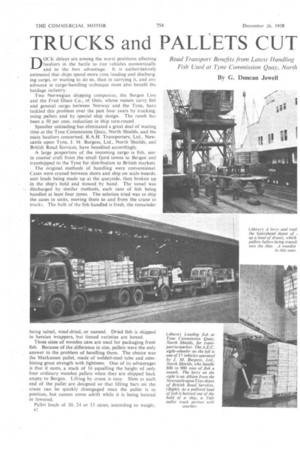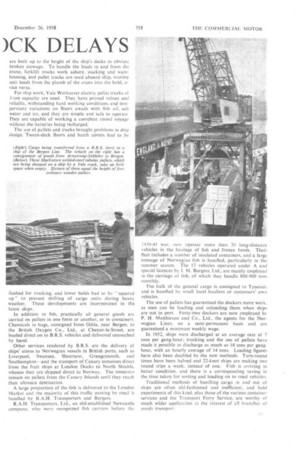TRUCKS and PALLETS CUT )CK DELAYS
Page 36

Page 37

If you've noticed an error in this article please click here to report it so we can fix it.
Road Transport Benefits from Latest Handling Fish Used at Tyne Commission Quay, North By G. Duncan Jewell
°CI(' delays are among the worst problems affecting
E)
hauliers in the battle to run vehicles economically and to the best advantage. It is authoritatively estimated that ships spend more time loading and discharging cargo, or waiting to do so, than in carrying it, and any advance in cargo-handling technique must also benefit the haulage industry.
Two Norwegian shipping companies, the Bergen Line and the Fred Olsen Co., of Oslo, whose vessels carry fish and general cargo between Norway and the Tyne, have tackled this problem over the past four years by trucking, using pallets and by special ship design. The result has been a 50 per cent. reduction in ship turn-round.
Speedier unloading has eliminated a great deal of waiting time at the Tyne Commission Quay, North Shields, and the main hauliers concerned, R.A.H. Transporters; Ltd., Newc,astle upon Tyne, J. M. Burgess, Ltd., North Shields, and British Road Services, have benefited accordingly.
A large proportion of the incoming cargo is fish, sent in coastal craft from the small fjord towns to Bergen and transhipped to the Tyne for distribution to British markets.
The original methods of handling were conventional. Cases were craned between shore and ship on scale-boards. unit loads being made up at the quayside, then broken up in the ship's hold and stowed by hand. The vessel was discharged by similar methods, each case of fish being handled at least four times. The solution tried was to ship the cases in units, moving them to and from the crane in trucks.. The bulk of the fish handled is fresh, the remainder being salted, wind-dried, or canned. Dried fish is shipped in hessian wrappers, but tinned varieties are boxed.
Three sizes of wooden case are used for packaging fresh fish. Because of the difference in size, pallets were the only answer to the problem of handling them. The choice was the Markussen pallet, made of welded-steel tube and combining great strength with lightness. One of its advantages is that it nests, a stack of 16 equalling the height of only four ordinary wooden pallets when they are shipped back empty to Bergen. Lifting by crane is easy. Slots at each end of the pallet are designed so that lifting bars on the crane can be quickly disengaged once the pallet is in position, but cannot come adrift while it is being hoisted or lowered.
Pallet loads of 30, 24 or 15 cases, according to weight, are built up to the height of the ship's decks to obviate broken stowage. To handle the loads to and from the crane, forklift trucks work ashore, stacking and ware. housing, and pallet trucks are used aboard ship, moving unit loads from the plumb of the crane into the hold, oi vice versa.
For ship work, Yale Worksaver electric pallet trucks ol 3-ton capacity are used. They have proved robust and reliable, withstanding hard working conditions and temperature variations on floors awash with fish oil, salt water and ice, and they are simple and safe to operate They are capable of working a complete round voyage without the batteries being recharged_ The use of pallets and trucks brought problems in ship design. Tween-deck floors and hatch covers had to be Rushed for trucking, and lower holds had to be squared up" to prevent shifting of cargo units during heavy weather. These developments are incorporated in the latest ships.
In addition to fish, practically all general goods are carried on pallets in one form or another, or in containers. Chemicals in bags, consigned from Odda, near Bergen; to the British Oxygen Co., Ltd., at Chester-le-Street, are loaded direct on to B.R.S. vehicles and delivered untouched by hand.
Other services rendered by B.R.S. are the delivery of ships. stores to Norwegian vessels in British ports, such as Liverpool, Swansea, Sheerness. Grangemouth, and Southampton—and the transport of Canary tomatoes direct from the fruit ships at London Docks to North Shields, whence they are shipped direct to Norway. The tomatoes remain on pallets from the Canary Islands until they reach their ultimate destination.
A large proportion of the fish is delivered to the London Market and the majority of this traffic passing by road is handled by R.A.H. Transporters and Burgess.
R.A.H. Transporters, Ltd., an old-established Newcastle company. who were recognized fish carriers before the
1939-45 war. now operate more than 20 Icing-distance vehicles in the haulage of fish and frozen foods. Their fleet includes a number of insulated containers, and a large tonnage of Norwegian fish is handled, particularly in the summer season. The 17 vehicles operated under A and special licences by J. M. Burgess, Ltd., are mainly employed in 'the carriage of fish, of which they handle 800-900 tons monthly.
The bulk of the general cargo is consigned to Tyneside and is handled by small local hauliers or customers' own vehicles.
The use of pallets has guaranteed the dockers more work, as men can be loading and unloading them when ships are not in port. Forty-two dockers are now employed by P. H. Matthieson and Co., Ltd., the agents for the Norwegian Lines, on a semi-permanent .basis and are guaranteed a minimum weekly wage.
In 1952, ships were discharged at an average rate of 7 tons per gang-hour; trucking and the use of pallets have made it possible to discharge as much as 18 tons per ganghour, with an hourly average of 14 tons. Loading figures have also been doubled by the new methods. Turn-round times have been halved and 22-knot ships are making two round trips a week, instead of one. Fish is arriving in better condition. and there is a corresponding saving in the time taken for sorting and loading on to road vehicles.
Traditional. methods of handling cargo in and out of ships are often old-fashioned and inefficient, and bold experiments of this kind, plus those of the various container services and the Transport Ferry Service, are worthy of much wider application in the interest of all branches of goods transport.








































































